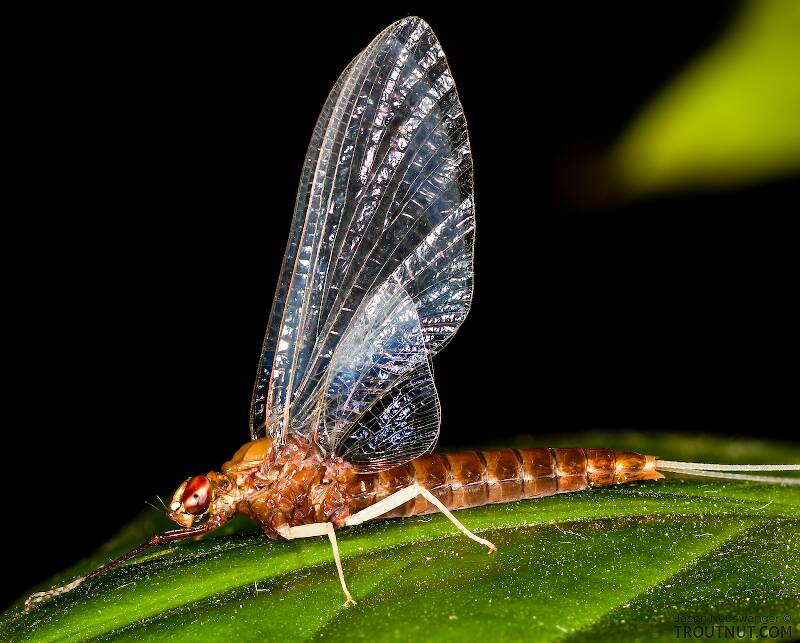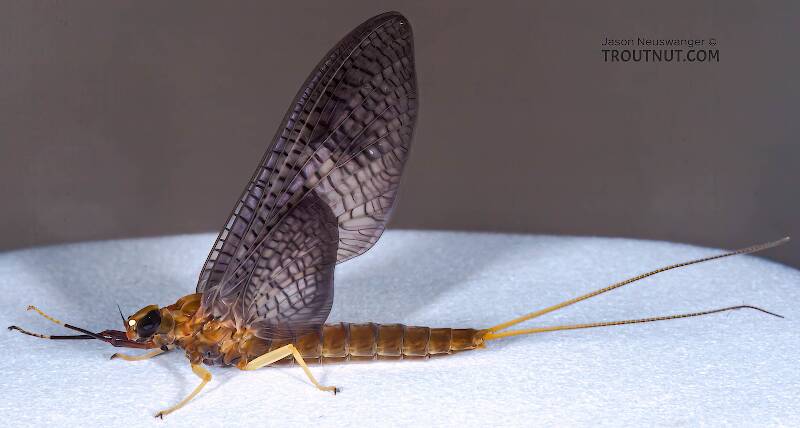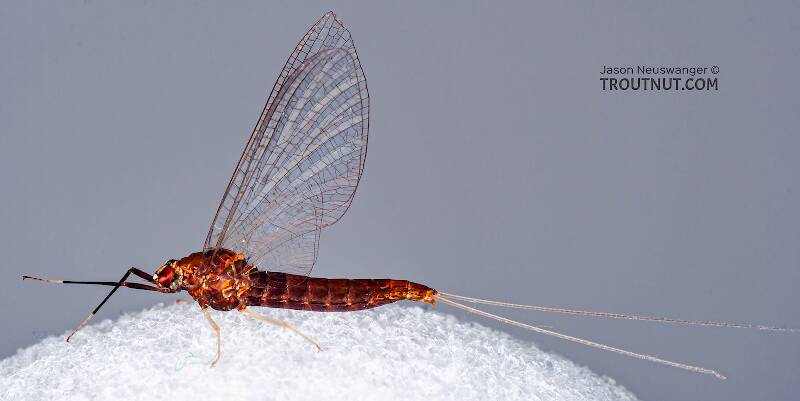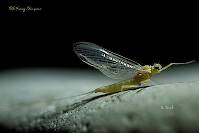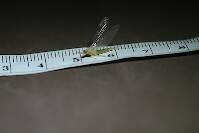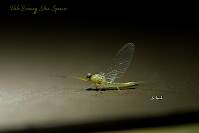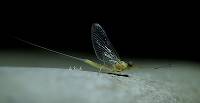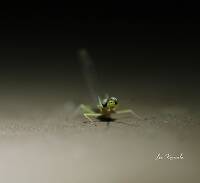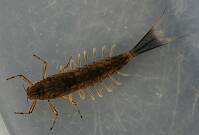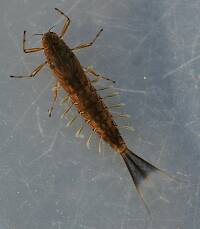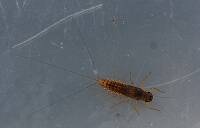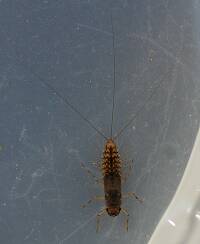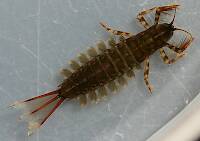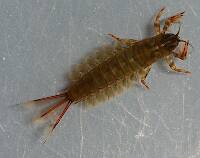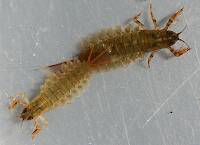
Salmonflies
Pteronarcys californica
The giant Salmonflies of the Western mountains are legendary for their proclivity to elicit consistent dry-fly action and ferocious strikes.
Featured on the forum

Troutnut is a project started in 2003 by salmonid ecologist Jason "Troutnut" Neuswanger to help anglers and
fly tyers unabashedly embrace the entomological side of the sport. Learn more about Troutnut or
support the project for an enhanced experience here.
This topic is about the Mayfly Genus Isonychia
Sporadic hatches are rarely as outstanding as those of Isonychia. On streams with good populations, they are reliably hatching in light numbers, here and there, for most of the evening through most of the mid- to late season.The spinners, and occasionally the duns, produce more concentrated action, but the real value of the Isonychia hatch is its duration and the size of the flies; large trout become ever watchful for them, even when they aren't emerging.
All the species of Isonychia are similar in appearance and behavior.
Example specimens
Troutnut on Jul 22, 2006July 22nd, 2006, 5:44 pm EDT
Here's what I've written in my article on Isonychia about their hatching:
I'm curious if they can really be called multibrooded or not, since they don't produce more than one generation per year (as far as I know). They simply have distinct populations within the same generation which emerge at different times during the year. Does that count?
All my books are packed up in boxes right now so I don't have a technical definition of the term handy.
Some Isonychia species are multibrooded, but not in the same way as most other multibrooded mayflies like the Baetidae. In those species, the flies emerging in midsummer or Fall are the offspring of the earlier hatch from the same year. In Isonychia, the Fall emergers are offspring from the previous Fall. They are present as half-grown nymphs when the first of their generation emerge. Although Isonychia broods have distinct peaks, some may be found on the water at any time in between.
I'm curious if they can really be called multibrooded or not, since they don't produce more than one generation per year (as far as I know). They simply have distinct populations within the same generation which emerge at different times during the year. Does that count?
All my books are packed up in boxes right now so I don't have a technical definition of the term handy.
Jason Neuswanger, Ph.D.
Troutnut and salmonid ecologist
Troutnut and salmonid ecologist
Taxon on Jul 22, 2006July 22nd, 2006, 7:59 pm EDT
Jason-
My understanding is that, in order for a species to be considered bivoltine, both an individual and its offspring would need to complete their lifecycles within a twelve month period. And of course, in order for a species to be considered trivoltine, the individual, their offspring, and the offspring's offspring would need to complete their lifecycles within a twelve month period.
I realize Merritt & Cummings has a table listing Isonychia bicolor as "bivoltine" and Isonychia spp. as "bi- or trivoltine (?)". However, my belief is that Isonychia spp. are really univoltine, as the life cycle for an individual is ~12 months.
In any event, I haven't been successful in finding a reference to Isonychia being multibrooded. Is that something you read while compiling notes?
My understanding is that, in order for a species to be considered bivoltine, both an individual and its offspring would need to complete their lifecycles within a twelve month period. And of course, in order for a species to be considered trivoltine, the individual, their offspring, and the offspring's offspring would need to complete their lifecycles within a twelve month period.
I realize Merritt & Cummings has a table listing Isonychia bicolor as "bivoltine" and Isonychia spp. as "bi- or trivoltine (?)". However, my belief is that Isonychia spp. are really univoltine, as the life cycle for an individual is ~12 months.
In any event, I haven't been successful in finding a reference to Isonychia being multibrooded. Is that something you read while compiling notes?
Troutnut on Jul 23, 2006July 23rd, 2006, 5:13 am EDT
I'm not sure where I heard that they're multibrooded, actually, and now that you mention it I don't see the term used in my notes. I've changed the paragraph accordingly:
Thanks.
Some people say the Isonychia species are multibrooded, but this is not technically correct, even though their pattern of emergence is similar. In true multibrooded mayflies like the Baetidae, the flies emerging in midsummer or Fall are the offspring of the earlier hatch from the same year. In Isonychia, the Fall emergers are offspring from the previous Fall. They are present as half-grown nymphs when the first of their generation emerge.
Thanks.
Jason Neuswanger, Ph.D.
Troutnut and salmonid ecologist
Troutnut and salmonid ecologist
Troutnut on Apr 15, 2009April 15th, 2009, 9:57 am EDT
A couple people have recently emailed me to help mediate a debate on this question. After initially and mistakenly giving a simple answer based on this discussion, I looked deeper into the literature and found that the issue is more interesting and complicated.
I couldn't find any explicit references on this question in the fly fishing literature. There's a lot of discussion of emergence periods, of whether bicolor should really be synonymous with sadleri and harperi or not, and of physical differences between regions and insects emerging at different times. However, I didn't find a reference in any of my angler-entomology books that addresses the question of whether the fall adults are the offspring of the adults from the same spring or the previous fall.
The most detailed related discussion is in the new edition of Ernest Schwiebert's Nymphs. While he did not give a direct answer, his discussion as a whole seems to imply the position taken earlier on this site: that there are somewhat distinct single-brooded populations emerging each year. (He also seems opposed to the combination of sadleri and harperi into the same species as bicolor, but that's a whole other can of worms.) Most relevant to this debate, he wrote (p. 277):
However, the scientific literature tells a different story. As Taxon pointed out, Merritt & Cummins have a life history table (page 70 in their 4th edition) that mentions a couple of these studies. The other one is listed in a 1984 review of the Isonychia genus in North and Central America by Kondratieff and Voshell (which also included some original field research on this question).
I only actually have one of these four primary sources, but based on the Kondratieff & Voshel paper and Merritt & Cummins table I gather that these are their conclusions:
Kondratieff & Voshel (1984): Found in Sinking Creek in Virginia that I. bicolor adults in early September came from eggs laid from May through July.
Jacobi & Benke (1991): Found an undetermined Isonychia species in Georgia to be bi- or possibly trivoltine.
Sweeney (1978): Found Isonychia bicolor in a Pennsylvania stream to be bivoltine.
Smith (1978): Found Isonychia bicolor in a Tennessee stream to be bivoltine.
Here are a few of the most relevant passages from Kondratieff & Voshel's paper (bold emphasis mine):
They found a different pattern in their other Virginia site:
**************
So, what's the bottom line? The evidence seems pretty conclusive that Isonychia can be multi-brooded (at least bivoltine, two generations per year), at least in relatively warm systems. However, even when this is the case, the broods can be so spread out and blurred together that it's difficult or impossible to distinguish between them. Based on my own experience and the fly fishing literature, it seems likely that in some northern systems they aren't multi-brooded, but no scientific studies have been done to rule one way or the other on that. My overall impression is that the emergence/generation schedule for many Isonychia populations is very complicated and maybe even chaotic, but that sometimes there are at least two generations per year.
**************
Obscure References
Jacobi, D.I. and A.C. Benke. 1991. Life histories and abundance patterns of snag-dwelling mayflies in a black-water coastal plain river. Journal of the North American Bethological Society 10:372-387.
Kondratieff, B.C., Voshell, J.R. 1984. The North and Central American Species of Isonychia (Ephemeroptera: Oligoneuriidae). Transactions of the American Entomological Society 110: 129-244.
Smith, J.G. 1978. The life histories, production rates and feeding habits of selected benthic macroinvertebrates of Spring Creek, Overton County, Tennessee. MS Thesis. Tenn. Tech. Univ., Cookeville, 164pp.
Sweeney, B.W. 1978. Bioenergetics and developmental response of a mayfly to thermal variation. Limnology and Oceanography 23:461-477.
I couldn't find any explicit references on this question in the fly fishing literature. There's a lot of discussion of emergence periods, of whether bicolor should really be synonymous with sadleri and harperi or not, and of physical differences between regions and insects emerging at different times. However, I didn't find a reference in any of my angler-entomology books that addresses the question of whether the fall adults are the offspring of the adults from the same spring or the previous fall.
The most detailed related discussion is in the new edition of Ernest Schwiebert's Nymphs. While he did not give a direct answer, his discussion as a whole seems to imply the position taken earlier on this site: that there are somewhat distinct single-brooded populations emerging each year. (He also seems opposed to the combination of sadleri and harperi into the same species as bicolor, but that's a whole other can of worms.) Most relevant to this debate, he wrote (p. 277):
Isonychia populations found near the southernmost limits of their range may emerge sporadically, appearing throughout the entire year. Each brood seems to require twelve months between eclosion {the nymph emerging from the egg} and hatching, although less time may be required in neotropical {from Mexico south} latitudes.
However, the scientific literature tells a different story. As Taxon pointed out, Merritt & Cummins have a life history table (page 70 in their 4th edition) that mentions a couple of these studies. The other one is listed in a 1984 review of the Isonychia genus in North and Central America by Kondratieff and Voshell (which also included some original field research on this question).
I only actually have one of these four primary sources, but based on the Kondratieff & Voshel paper and Merritt & Cummins table I gather that these are their conclusions:
Kondratieff & Voshel (1984): Found in Sinking Creek in Virginia that I. bicolor adults in early September came from eggs laid from May through July.
Jacobi & Benke (1991): Found an undetermined Isonychia species in Georgia to be bi- or possibly trivoltine.
Sweeney (1978): Found Isonychia bicolor in a Pennsylvania stream to be bivoltine.
Smith (1978): Found Isonychia bicolor in a Tennessee stream to be bivoltine.
Here are a few of the most relevant passages from Kondratieff & Voshel's paper (bold emphasis mine):
Smith (1978) and Sweeney (1978) found I. bicolor to be bivoltine with a spring and summer generation. Sweeney showed that female subimago body size and fecundity for the overwintering spring emerging generation was about double that of the smaller summer emerging generation. His study indicated that temperature affected both nymphal tissue growth and the rate of adult tissue maturation, and was a key factor in determining the distribution, life history, and fecundity of I. bicolor.
At both (Virginia) sites the developmental cycles were relatively complex. At Sinking Creek there was an emergence of an overwintering brood of predominantly large adults in May and another peak of smaller individuals emerging in mid-September. Adults and/or mature nymphs, however, were present from May to October. The overlapping of generations was produced by the overwintering of various developmental stages. Little growth occurred from December to March. The lare overwintering nymphs (usually females) emerged first (early May) followed by gradually smaller adults from June to early October. Increasing water temperatures probably resulted in faster development and smaller-sized adults during these months. Eggs laid during May to early July produced the September peak. Eggs laid by the summer and fall emerging adults formed the overwintering population.
They found a different pattern in their other Virginia site:
At the Little River, there were no discrete generations detectable. Adults or mature nymphs were collected from June to mid-November. Adults exhibited little size variation or color variability throughout the year, apparently because of warmer water temperatures that extended over a longer period of time.
**************
So, what's the bottom line? The evidence seems pretty conclusive that Isonychia can be multi-brooded (at least bivoltine, two generations per year), at least in relatively warm systems. However, even when this is the case, the broods can be so spread out and blurred together that it's difficult or impossible to distinguish between them. Based on my own experience and the fly fishing literature, it seems likely that in some northern systems they aren't multi-brooded, but no scientific studies have been done to rule one way or the other on that. My overall impression is that the emergence/generation schedule for many Isonychia populations is very complicated and maybe even chaotic, but that sometimes there are at least two generations per year.
**************
Obscure References
Jacobi, D.I. and A.C. Benke. 1991. Life histories and abundance patterns of snag-dwelling mayflies in a black-water coastal plain river. Journal of the North American Bethological Society 10:372-387.
Kondratieff, B.C., Voshell, J.R. 1984. The North and Central American Species of Isonychia (Ephemeroptera: Oligoneuriidae). Transactions of the American Entomological Society 110: 129-244.
Smith, J.G. 1978. The life histories, production rates and feeding habits of selected benthic macroinvertebrates of Spring Creek, Overton County, Tennessee. MS Thesis. Tenn. Tech. Univ., Cookeville, 164pp.
Sweeney, B.W. 1978. Bioenergetics and developmental response of a mayfly to thermal variation. Limnology and Oceanography 23:461-477.
Jason Neuswanger, Ph.D.
Troutnut and salmonid ecologist
Troutnut and salmonid ecologist
GONZO on Apr 17, 2009April 17th, 2009, 8:10 am EDT
Jason,
The literature you mention indicates a general pattern in which the incidence of multivoltinism increases with increases in mean temperature (decreasing latitude). That seems reasonable. Isonychia (bicolor) is probably bivoltine in most of the streams that I fish. Although it shows a relatively high growth rate for a large mayfly, it also seems possible that it might be univoltine in the northernmost part of its range. As mean temperature increases further, there is also a tendency for generations to overlap (size/temporal distribution) and emergence to become asynchronous creating a very extended emergence period in which sizes/generations are mixed. In very general terms, tendencies toward multivoltinism and asynchronous emergence increase as mean temperature increases and latitude decreases. In other words, many (North American) mayflies become multibrooded and/or develop lengthy scattered emergences as you move south toward warmer waters. No big surprise there.
The Jacobi & Benke (1991) paper was particularly interesting in that it compared different mayfly families occuring in the same habitat. The general tendency to move from univoltine (or even semivoltine) to multivoltine to mixed/overlapping generations as mean temperature increases seems to hold for many families, but not all mayflies respond to these changes in the same way (or at the same rate).
Here is what I would extrapolate (speculate?) from the studies of mayfly voltinism that I have read:
1. Ephemerellidae--voltinism in this family seems to be the least affected by temperature/latitude changes. They seem to retain a univoltine life cycle and fairly synchronized emergence periods over most of their North American range. Although there seems to be some evidence that distinct cohorts might develop within a (univoltine) generation or that emergences could be significantly longer or shorter in some locales/temperature regimes, the univoltine pattern seems most consistent within this group. They may even decline in regimes that tend to produce multivoltinism in other families (suggesting that they might be especially sensitive to climate change?).
2. Baetidae--probably due to their rapid growth rates, most members of this family seem to respond readily to mean temperature increases with multivoltinism. I have seen speculation (based on growth rates) suggesting that some baetids (B. quilleri) have the potential to produce as many as 10 generations/year under optimal conditions. Although some species are univoltine in the northern part of their range, under warmer or more consistent temperature regimes, baetids can display a nearly continuous emergence of mixed/overlapping broods.
3. Heptageniidae--most members of this family seem to have a univoltine pattern in the streams that I fish, but some also develop multivoltine or lengthy overlapping emergences in their southern range. Although I'm not sure if there is evidence of distinct cohorts developing within a univoltine generation, I have seen significant variations in the length of their emergences and perhaps some anecdotal indications of a tendency to be slightly less synchronous in the timing of their emergence when compared to many ephemerellids in the same streams. An interesting aspect of this family is that cold-loving species that show significant winter growth (i.e. Epeorus pleuralis) have a much longer emergence period in headwaters with consistently cold temperatures (Minshall, 1967).
4. Isonychiidae--the difficulty of identifying/separating species complicates some studies, but bicolor (at least) seems to be bivoltine in much of its range, even in many cool-water streams. Some Isonychia might be trivoltine in some parts of the South, and Berner and Pescador (1988) found that I. sayi emerged throughout most of the year in Florida. Jacobi and Benke (1991) also found that some supposed "cohorts" (fairly synchronous groups) were comprised of overlapping emergences of two species (I. georgiae and I. sayi). I haven't found any studies that indicate whether Isonychia becomes univoltine toward the northern end of its range, but life histories of many species seem uncertain or unstudied.
5. Leptohyphidae/Caenidae--these families seem to display multivoltinism over much of their range. With regard to Tricorythodes and Caenis, that seems to apply to many cool-water environs as well as warmer waters. This appears to produce a lengthy, overlapping, mixed size/brood emergence on some waters. That tendency is probably more prevalent in warmer regimes, and may be comprised of 4-5 generations in some areas.
6. Ephemeridae--other studies suggest that some members of this family are semivoltine in the north and may even become multivoltine in some southern waters. I haven't come across anything in the literature regarding shifts in patterns of voltinism over the more limited range of most Ephemera species, but some wide-ranging Hexagenia species apparently make this modification (at least from semivoltine to univoltine).
The literature you mention indicates a general pattern in which the incidence of multivoltinism increases with increases in mean temperature (decreasing latitude). That seems reasonable. Isonychia (bicolor) is probably bivoltine in most of the streams that I fish. Although it shows a relatively high growth rate for a large mayfly, it also seems possible that it might be univoltine in the northernmost part of its range. As mean temperature increases further, there is also a tendency for generations to overlap (size/temporal distribution) and emergence to become asynchronous creating a very extended emergence period in which sizes/generations are mixed. In very general terms, tendencies toward multivoltinism and asynchronous emergence increase as mean temperature increases and latitude decreases. In other words, many (North American) mayflies become multibrooded and/or develop lengthy scattered emergences as you move south toward warmer waters. No big surprise there.
The Jacobi & Benke (1991) paper was particularly interesting in that it compared different mayfly families occuring in the same habitat. The general tendency to move from univoltine (or even semivoltine) to multivoltine to mixed/overlapping generations as mean temperature increases seems to hold for many families, but not all mayflies respond to these changes in the same way (or at the same rate).
Here is what I would extrapolate (speculate?) from the studies of mayfly voltinism that I have read:
1. Ephemerellidae--voltinism in this family seems to be the least affected by temperature/latitude changes. They seem to retain a univoltine life cycle and fairly synchronized emergence periods over most of their North American range. Although there seems to be some evidence that distinct cohorts might develop within a (univoltine) generation or that emergences could be significantly longer or shorter in some locales/temperature regimes, the univoltine pattern seems most consistent within this group. They may even decline in regimes that tend to produce multivoltinism in other families (suggesting that they might be especially sensitive to climate change?).
2. Baetidae--probably due to their rapid growth rates, most members of this family seem to respond readily to mean temperature increases with multivoltinism. I have seen speculation (based on growth rates) suggesting that some baetids (B. quilleri) have the potential to produce as many as 10 generations/year under optimal conditions. Although some species are univoltine in the northern part of their range, under warmer or more consistent temperature regimes, baetids can display a nearly continuous emergence of mixed/overlapping broods.
3. Heptageniidae--most members of this family seem to have a univoltine pattern in the streams that I fish, but some also develop multivoltine or lengthy overlapping emergences in their southern range. Although I'm not sure if there is evidence of distinct cohorts developing within a univoltine generation, I have seen significant variations in the length of their emergences and perhaps some anecdotal indications of a tendency to be slightly less synchronous in the timing of their emergence when compared to many ephemerellids in the same streams. An interesting aspect of this family is that cold-loving species that show significant winter growth (i.e. Epeorus pleuralis) have a much longer emergence period in headwaters with consistently cold temperatures (Minshall, 1967).
4. Isonychiidae--the difficulty of identifying/separating species complicates some studies, but bicolor (at least) seems to be bivoltine in much of its range, even in many cool-water streams. Some Isonychia might be trivoltine in some parts of the South, and Berner and Pescador (1988) found that I. sayi emerged throughout most of the year in Florida. Jacobi and Benke (1991) also found that some supposed "cohorts" (fairly synchronous groups) were comprised of overlapping emergences of two species (I. georgiae and I. sayi). I haven't found any studies that indicate whether Isonychia becomes univoltine toward the northern end of its range, but life histories of many species seem uncertain or unstudied.
5. Leptohyphidae/Caenidae--these families seem to display multivoltinism over much of their range. With regard to Tricorythodes and Caenis, that seems to apply to many cool-water environs as well as warmer waters. This appears to produce a lengthy, overlapping, mixed size/brood emergence on some waters. That tendency is probably more prevalent in warmer regimes, and may be comprised of 4-5 generations in some areas.
6. Ephemeridae--other studies suggest that some members of this family are semivoltine in the north and may even become multivoltine in some southern waters. I haven't come across anything in the literature regarding shifts in patterns of voltinism over the more limited range of most Ephemera species, but some wide-ranging Hexagenia species apparently make this modification (at least from semivoltine to univoltine).
Quick Reply
Related Discussions
Topic
Replies
Last Reply
Re: Lots of new pictures to check out, coming online tonight/tomorrow
In General Discussion by Troutnut
In General Discussion by Troutnut
1
Oct 4, 2006
by Dinerobyn
by Dinerobyn
5
Sep 10, 2020
by Leskorcala
by Leskorcala
6
Feb 19, 2017
by Jmd123
by Jmd123



